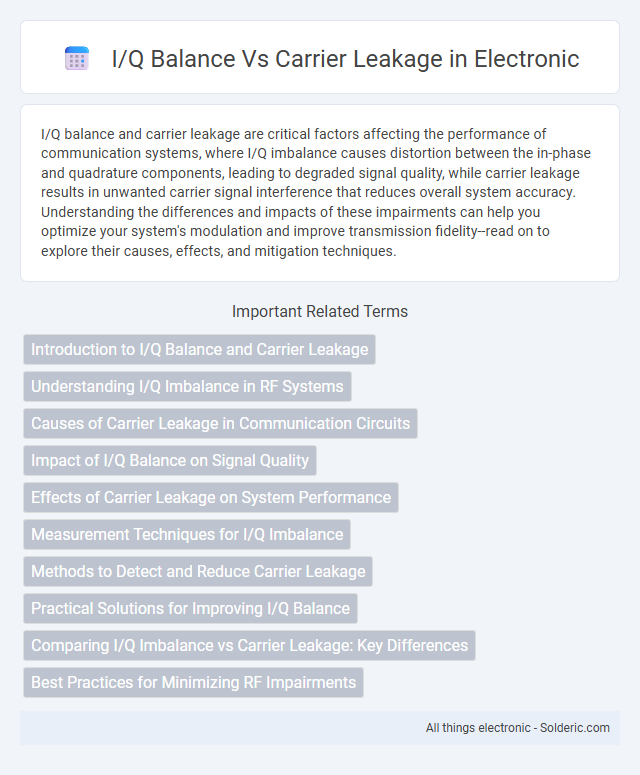I/Q balance and carrier leakage are critical factors affecting the performance of communication systems, where I/Q imbalance causes distortion between the in-phase and quadrature components, leading to degraded signal quality, while carrier leakage results in unwanted carrier signal interference that reduces overall system accuracy. Understanding the differences and impacts of these impairments can help you optimize your system's modulation and improve transmission fidelity--read on to explore their causes, effects, and mitigation techniques.
Comparison Table
| Aspect | I/Q Balance | Carrier Leakage |
|---|---|---|
| Definition | Mismatch in amplitude and phase between I (In-phase) and Q (Quadrature) signal paths. | Unwanted leakage of the carrier signal into the output due to imperfect mixing or LO feedthrough. |
| Cause | Component tolerances, mismatched gain, phase errors in mixers or analog front-end. | Direct coupling of local oscillator (LO) leakage, insufficient isolation. |
| Effect on Signal | Generates image interference, degrades modulation accuracy, distorts constellation points. | Introduces DC offset or spurious tones, reduces signal-to-noise ratio (SNR). |
| Measurement Parameters | Amplitude imbalance (dB), Phase error (degrees). | Carrier leakage level (dBc or dB). |
| Correction Method | Calibration algorithms, adaptive digital compensation. | Filtering, improved LO isolation, compensation circuitry. |
| Impact on Communication Systems | Affects modulation fidelity in QAM, OFDM systems. | Causes baseline offset, reduces receiver sensitivity. |
| Typical Domain | I/Q modulators and demodulators. | Mixers, frequency converters, RF front-end. |
Introduction to I/Q Balance and Carrier Leakage
I/Q balance refers to the precise matching of amplitude and phase between the in-phase (I) and quadrature (Q) signals in communication systems, crucial for maintaining signal integrity and minimizing distortion. Carrier leakage occurs when a portion of the local oscillator signal leaks into the output, causing unwanted interference and degrading system performance. Understanding the differences between I/Q balance and carrier leakage helps you optimize wireless transmission quality and reduce errors in complex modulation schemes.
Understanding I/Q Imbalance in RF Systems
I/Q imbalance in RF systems occurs when the in-phase (I) and quadrature-phase (Q) signal paths exhibit mismatched amplitude or phase characteristics, leading to distorted signal constellations and degraded modulation accuracy. Carrier leakage, often caused by imperfect local oscillator suppression or I/Q imbalance, manifests as an unwanted DC offset at the receiver, reducing signal-to-noise ratio and increasing error vector magnitude (EVM). Accurate calibration and digital compensation methods, including adaptive algorithms, are essential to mitigate I/Q imbalance and minimize carrier leakage, ensuring optimal RF system performance in communication devices.
Causes of Carrier Leakage in Communication Circuits
Carrier leakage in communication circuits primarily arises from imperfect matching in the I/Q modulator components, such as amplitude and phase imbalances between the in-phase (I) and quadrature-phase (Q) paths. Non-idealities in mixers, local oscillator feedthrough, and layout asymmetry contribute to residual carrier signals leaking into the modulated output. Temperature variations and process mismatches during fabrication further exacerbate these imbalances, increasing the degree of carrier leakage and degrading signal quality.
Impact of I/Q Balance on Signal Quality
I/Q balance significantly affects signal quality by minimizing distortion in quadrature amplitude modulation (QAM) and other complex modulation schemes. Imbalanced I/Q components introduce amplitude and phase errors, leading to constellation warping and increased error vector magnitude (EVM), which degrade overall system performance. Precise I/Q matching reduces carrier leakage and intermodulation products, enhancing signal fidelity and improving bit error rate (BER) in communication systems.
Effects of Carrier Leakage on System Performance
Carrier leakage in communication systems causes I/Q imbalance, leading to distortion and degradation of signal quality. This interference reduces signal-to-noise ratio (SNR), increases bit error rates (BER), and impairs overall system reliability. Your system performance can be significantly optimized by minimizing carrier leakage through proper calibration and signal processing techniques.
Measurement Techniques for I/Q Imbalance
Measurement techniques for I/Q imbalance include vector signal analyzers and digital signal processing methods that capture amplitude and phase discrepancies between in-phase (I) and quadrature (Q) components. These techniques often involve using calibration signals and applying correction algorithms to isolate and quantify the imbalance affecting modulated signals. Precise assessment is critical for minimizing constellation distortion and enhancing the overall performance of communication receivers and transceivers.
Methods to Detect and Reduce Carrier Leakage
You can detect carrier leakage by analyzing the DC offset in the received signal's IQ components using spectrum analysis or vector network analyzers. Techniques to reduce carrier leakage include implementing adaptive digital predistortion algorithms and employing quadrature error calibration through IQ imbalance correction. Passive methods such as tuning the local oscillator phase and amplitude or using high-quality components with precise matching also minimize leakage effectively.
Practical Solutions for Improving I/Q Balance
Practical solutions for improving I/Q balance involve calibration techniques such as adaptive digital pre-distortion and analog trimming to minimize amplitude and phase mismatches in quadrature mixers. Employing high-precision components and temperature compensation circuits enhances stability and reduces imbalance over varying operational conditions. Advanced algorithms leveraging real-time error feedback enable continuous correction of I/Q imbalance, effectively mitigating carrier leakage in wireless communication systems.
Comparing I/Q Imbalance vs Carrier Leakage: Key Differences
I/Q imbalance refers to the mismatch in amplitude and phase between the in-phase (I) and quadrature (Q) components of a signal, causing distortion and degraded signal quality. Carrier leakage arises when an unintended portion of the carrier frequency leaks into the transmitted signal, resulting in a constant offset and interference. Understanding these key differences helps you optimize signal processing techniques to improve communication system performance.
Best Practices for Minimizing RF Impairments
Minimizing RF impairments such as I/Q balance errors and carrier leakage requires precise calibration and adaptive compensation techniques in the signal processing chain. Implementing vector modulator calibration and digital predistortion algorithms can significantly reduce amplitude and phase mismatches, ensuring optimal quadrature accuracy. Maintaining strict temperature control and utilizing high-quality components further enhance system linearity and suppress unwanted carrier leakage.
I/Q balance vs carrier leakage Infographic

 solderic.com
solderic.com